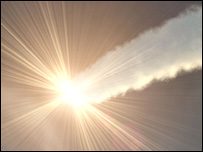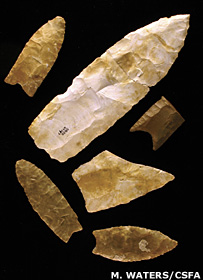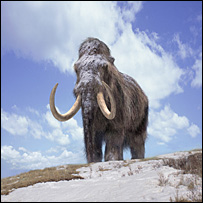
Ice Age blast 'ravaged America'
A controversial new idea suggests that a large space rock exploded over North America 13,000 years ago. The blast may have wiped out one of America's first Stone Age cultures as well as the continent's big mammals such as the mammoth and the mastodon. The blast, from a comet or asteroid, caused a major bout of climatic cooling which may also have affected human cultures emerging in Europe and Asia. Scientists will outline their evidence this week at a meeting in Mexico.
Their impact theory shouldn't be dismissed; it deserves further investigation -- Jeff Severinghaus, Scripps Institution of Oceanography The evidence comes from layers of sediment at more than 20 sites across North America.
All, they argue, point to the explosion 12,900 years ago of an extraterrestrial object up to 5km across. No crater remains, possibly because the Laurentide Ice Sheet, which blanketed thousands of sq km of North America during the last Ice Age, was thick enough to mask the impact. Another possibility is that it exploded in the air. Climate Cooling The rocks studied by the researchers have a black layer which, they argue, is the charcoal deposited by wildfires which swept the continent after the explosion.
Professor James Kennett, from the University of California in Santa Barbara (UCSB), said the explosion could be to blame for the extinction of several large North American mammals at the end of the last Ice Age. "All the elephants, including the mastodon and the mammoth, all the ground sloths, including the giant ground sloth - which, when standing on its hind legs, would have been as big as a mammoth," he told the BBC. "All the horses went out, all the North American camels went out. There were large carnivores like the sabre-toothed cat and an enormous bear called the short-faced bear." Professor Kennett said this could have had an enormous impact on human populations. Population Decline According to the traditional view, humans crossed from north-east Asia to America at the end of the last Ice Age, across a land bridge which - at the time - connected Siberia to Alaska.
But there is no evidence of a similar decline in other parts of the continent. The Clovis culture does vanish from the archaeological record abruptly, but it is replaced by a myriad of different local hunter-gatherer cultures. Jeff Severinghaus, a palaeoclimatologist at Scripps Institution of Oceanography in California, told Nature magazine: "Their impact theory shouldn't be dismissed; it deserves further investigation." According to the new idea, the comet would have caused widespread melting of the North American ice sheet. The waters would have poured into the Atlantic, disrupting its currents. This, they say, could have caused the 1,000 year-long Younger Dryas cold spell, which also affected Asia and Europe. The Younger Dryas has been linked by some researchers to changes in the living patterns of people living in the Middle East which led to the beginning of farming. A massive explosion near the Tunguska river, Siberia, in 1908, is also thought to have been caused by a space rock exploding in the atmosphere. It felled 80 million trees over an area of 2,000 sq km. The new theory will be presented and debated at the American Geophysical Union's Joint Meeting in Acapulco, Mexico, in late May 2007.
|
 These sediments contain exotic materials: tiny spheres of glass and carbon, ultra-small specks of diamond - called nanodiamond - and amounts of the rare element iridium that are too high to have come from Earth.
These sediments contain exotic materials: tiny spheres of glass and carbon, ultra-small specks of diamond - called nanodiamond - and amounts of the rare element iridium that are too high to have come from Earth. Clovis hunting points, Center for the Study of the First Americans
The Clovis people developed an advanced stone tool technology
The blast would not only have generated enormous amounts of heat that could have given rise to wildfires, but also brought about a period of climate cooling that lasted 1,000 years - an event known as the Younger Dryas.
Clovis hunting points, Center for the Study of the First Americans
The Clovis people developed an advanced stone tool technology
The blast would not only have generated enormous amounts of heat that could have given rise to wildfires, but also brought about a period of climate cooling that lasted 1,000 years - an event known as the Younger Dryas. The Clovis culture was one of the earliest known cultures in the continent. These proficient hunter-gatherers developed a distinctive thin, fluted spear head known as the Clovis point, which is regarded as one of the most sophisticated stone tools ever developed.
Archaeologists have found evidence from the Topper site in South Carolina, US, that Clovis populations here went through a population collapse.
The Clovis culture was one of the earliest known cultures in the continent. These proficient hunter-gatherers developed a distinctive thin, fluted spear head known as the Clovis point, which is regarded as one of the most sophisticated stone tools ever developed.
Archaeologists have found evidence from the Topper site in South Carolina, US, that Clovis populations here went through a population collapse.